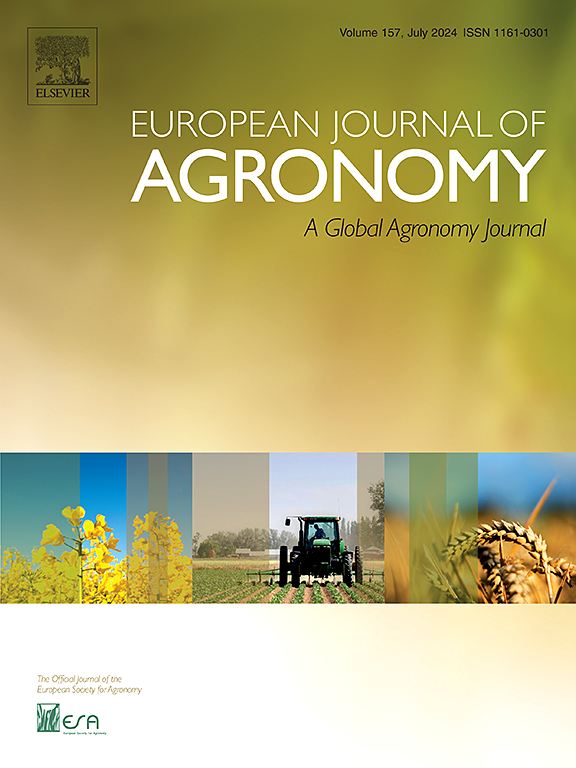Maize yield estimation based on UAV multispectral monitoring of canopy LAI and WOFOST data assimilation
IF 4.5
1区 农林科学
Q1 AGRONOMY
引用次数: 0
Abstract
The estimation accuracy of crop model is influenced by model parameters, model inputs, and model structure. Data assimilation was frequently employed to enhance model performance. To evaluate the feasibility of data assimilation by UAV remote sensing and WOFOST in improving maize yield prediction, a set of field experiments was conducted in Mangshi, Yunnan Province, from 2023 to 2024. Based on the canopy remote sensing data collected by UAV, five inversion models of leaf area index (LAI) were developed using machine learning methods, i.e. Random Forest (RF), Partial Least Squares (PLS), Ridge Regression (RR), k-Nearest Neighbors (KNN), and Extreme Gradient Boosting (XGBoost), the best-performing inversion model was selected for data assimilation. Field trials data were used to calibrate the WOFOST model, and the ensemble Kalman filter (ENKF) was applied to assimilate inverted LAI. The results showed that the RF-based inversion model provided the highest accuracy in estimating LAI, with R² of 0.82 and NRMSE of 18 %. For the calibrated model, the NRMSE of yield and LAI were 12 % and 34 %, respectively. After assimilation, the NRMSE for yield and LAI decreased to 4 % and 15 %, respectively, and the average yield error was reduced by 808 kg/ha. Multiple rounds of assimilation reduced both the error range and bias caused by parameters uncertainty. This study demonstrates that assimilating UAV-inverted LAI with RF into the WOFOST model effectively enhances its ability to simulate dynamic crop growth and reduces uncertainty. The effect of data assimilation on the interaction of various uncertainties in the model needs further research. This research offers valuable insights into applying UAV remote sensing and data assimilation technologies for precision maize management.
基于无人机多光谱监测冠层LAI和WOFOST数据同化的玉米产量估算
作物模型的估计精度受模型参数、模型输入和模型结构的影响。通常采用数据同化来提高模型性能。为评估无人机遥感数据同化与WOFOST在玉米产量预测中的可行性,于2023 - 2024年在云南芒市进行了一组田间试验。基于无人机采集的冠层遥感数据,利用机器学习方法建立了随机森林(Random Forest, RF)、偏最小二乘(PLS)、岭回归(Ridge Regression, RR)、k近邻(k-Nearest Neighbors, KNN)和极限梯度提升(Extreme Gradient boost, XGBoost) 5种叶面积指数(LAI)反演模型,并选择了表现最好的模型进行数据同化。利用野外试验数据对WOFOST模型进行校正,采用集合卡尔曼滤波(ENKF)同化反演LAI。结果表明,基于rf的反演模型对LAI的估计精度最高,R²为0.82,NRMSE为18 %。校正后的模型产量和LAI的NRMSE分别为12 %和34 %。同化后,产量和LAI的NRMSE分别降至4 %和15 %,平均产量误差降低了808 kg/ha。多轮同化既减小了误差范围,又减小了参数不确定性引起的偏差。研究表明,在WOFOST模型中吸收带有RF的无人机反演LAI能有效提高模型模拟作物动态生长的能力,降低不确定性。数据同化对模型中各种不确定性相互作用的影响有待进一步研究。该研究为应用无人机遥感和数据同化技术进行玉米精准管理提供了有价值的见解。
本文章由计算机程序翻译,如有差异,请以英文原文为准。
求助全文
约1分钟内获得全文
求助全文
来源期刊

European Journal of Agronomy
农林科学-农艺学
CiteScore
8.30
自引率
7.70%
发文量
187
审稿时长
4.5 months
期刊介绍:
The European Journal of Agronomy, the official journal of the European Society for Agronomy, publishes original research papers reporting experimental and theoretical contributions to field-based agronomy and crop science. The journal will consider research at the field level for agricultural, horticultural and tree crops, that uses comprehensive and explanatory approaches. The EJA covers the following topics:
crop physiology
crop production and management including irrigation, fertilization and soil management
agroclimatology and modelling
plant-soil relationships
crop quality and post-harvest physiology
farming and cropping systems
agroecosystems and the environment
crop-weed interactions and management
organic farming
horticultural crops
papers from the European Society for Agronomy bi-annual meetings
In determining the suitability of submitted articles for publication, particular scrutiny is placed on the degree of novelty and significance of the research and the extent to which it adds to existing knowledge in agronomy.
 求助内容:
求助内容: 应助结果提醒方式:
应助结果提醒方式:


